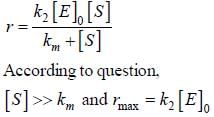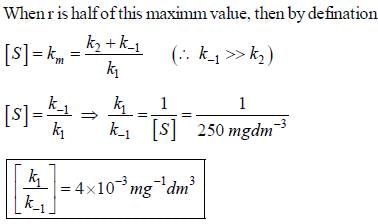Chemistry Exam > Chemistry Questions > For an enzyme-substrate system obeying the si...
Start Learning for Free
For an enzyme-substrate system obeying the simple Michaelis-Meten mechanism, the rate of product formation when the substrate concentration is very large, has the limiting value 0.02 moldm-3 . At a substrate concentration of 250 mg/dm3, the rate is half this value. The value of k1/k-1 is _______ x 10-3 dm3mg-1. [Assuming that k2<<k-1](answer should be an integer).
Correct answer is '4'. Can you explain this answer?
| FREE This question is part of | Download PDF Attempt this Test |
Verified Answer
For an enzyme-substrate system obeying the simple Michaelis-Meten mech...


Most Upvoted Answer
For an enzyme-substrate system obeying the simple Michaelis-Meten mech...
= 0.02 moldm-3 and that the units for k1 and k-1 are dm3mol-1s-1 and the units for substrate concentration are mg/dm3.]
First, we need to convert the units of substrate concentration from mg/dm3 to moldm-3:
250 mg/dm3 = 0.25 g/dm3 = 0.25 x 10^-3 kg/dm3
Molar mass of substrate = 100 g/mol
Concentration in moles per dm3 = (0.25 x 10^-3 kg/dm3) / (100 g/mol) = 2.5 x 10^-6 mol/dm3 = 2.5 µmol/dm3
Substrate concentration in moldm-3 = 2.5 x 10^-6 mol/dm3
According to the Michaelis-Menten mechanism, the rate of product formation can be described by the following equation:
v = k2 [ES]
where v is the rate of product formation, k2 is the rate constant for the conversion of enzyme-substrate complex (ES) to product, and [ES] is the concentration of ES complex.
At very high substrate concentrations, all of the enzyme molecules are bound to substrate, so the concentration of ES complex is equal to the total enzyme concentration ([E]total):
[ES] = [E]total
v = k2 [E]total
At this point, the rate of product formation is at its maximum, which is given as 0.02 moldm-3. Therefore:
0.02 moldm-3 = k2 [E]total
At a substrate concentration of 2.5 µmol/dm3, the rate is half the maximum value:
0.01 moldm-3 = k2 [E]total
Dividing these two equations, we can eliminate [E]total and solve for k2:
0.02 moldm-3 / 0.01 moldm-3 = k2/k2
k2 = 2 x 10^-2 dm3mol-1s-1
The Michaelis constant (Km) can be calculated as half the maximum rate divided by the substrate concentration at half the maximum rate:
Km = (0.02 moldm-3 / 2) / 2.5 x 10^-6 mol/dm3 = 4 x 10^3 dm3mol-1
Using the relationship between k1, k-1, and Km:
k2 / Km = k1 / k-1 + Km / k-1
Substituting the values we have found:
2 x 10^-2 dm3mol-1s-1 / 4 x 10^3 dm3mol-1 = k1 / k-1 + 4 x 10^3 dm3mol-1 / k-1
Simplifying and solving for k1/k-1:
k1/k-1 = (2 x 10^-2 dm3mol-1s-1 / 4 x 10^3 dm3mol-1) - 4 x 10^3 dm3mol-1 / (4 x 10^3 dm3mol-1)
k1/k-1 = -1.5 x 10^-3 dm3mg-
First, we need to convert the units of substrate concentration from mg/dm3 to moldm-3:
250 mg/dm3 = 0.25 g/dm3 = 0.25 x 10^-3 kg/dm3
Molar mass of substrate = 100 g/mol
Concentration in moles per dm3 = (0.25 x 10^-3 kg/dm3) / (100 g/mol) = 2.5 x 10^-6 mol/dm3 = 2.5 µmol/dm3
Substrate concentration in moldm-3 = 2.5 x 10^-6 mol/dm3
According to the Michaelis-Menten mechanism, the rate of product formation can be described by the following equation:
v = k2 [ES]
where v is the rate of product formation, k2 is the rate constant for the conversion of enzyme-substrate complex (ES) to product, and [ES] is the concentration of ES complex.
At very high substrate concentrations, all of the enzyme molecules are bound to substrate, so the concentration of ES complex is equal to the total enzyme concentration ([E]total):
[ES] = [E]total
v = k2 [E]total
At this point, the rate of product formation is at its maximum, which is given as 0.02 moldm-3. Therefore:
0.02 moldm-3 = k2 [E]total
At a substrate concentration of 2.5 µmol/dm3, the rate is half the maximum value:
0.01 moldm-3 = k2 [E]total
Dividing these two equations, we can eliminate [E]total and solve for k2:
0.02 moldm-3 / 0.01 moldm-3 = k2/k2
k2 = 2 x 10^-2 dm3mol-1s-1
The Michaelis constant (Km) can be calculated as half the maximum rate divided by the substrate concentration at half the maximum rate:
Km = (0.02 moldm-3 / 2) / 2.5 x 10^-6 mol/dm3 = 4 x 10^3 dm3mol-1
Using the relationship between k1, k-1, and Km:
k2 / Km = k1 / k-1 + Km / k-1
Substituting the values we have found:
2 x 10^-2 dm3mol-1s-1 / 4 x 10^3 dm3mol-1 = k1 / k-1 + 4 x 10^3 dm3mol-1 / k-1
Simplifying and solving for k1/k-1:
k1/k-1 = (2 x 10^-2 dm3mol-1s-1 / 4 x 10^3 dm3mol-1) - 4 x 10^3 dm3mol-1 / (4 x 10^3 dm3mol-1)
k1/k-1 = -1.5 x 10^-3 dm3mg-

|
Explore Courses for Chemistry exam
|

|
Similar Chemistry Doubts
For an enzyme-substrate system obeying the simple Michaelis-Meten mechanism, the rate of product formation when the substrate concentration is very large, has the limiting value 0.02 moldm-3. At a substrate concentration of 250 mg/dm3, the rate is half this value. The value of k1/k-1 is _______ x 10-3 dm3mg-1. [Assuming that k2<<k-1](answer should be an integer).Correct answer is '4'. Can you explain this answer?
Question Description
For an enzyme-substrate system obeying the simple Michaelis-Meten mechanism, the rate of product formation when the substrate concentration is very large, has the limiting value 0.02 moldm-3. At a substrate concentration of 250 mg/dm3, the rate is half this value. The value of k1/k-1 is _______ x 10-3 dm3mg-1. [Assuming that k2<<k-1](answer should be an integer).Correct answer is '4'. Can you explain this answer? for Chemistry 2024 is part of Chemistry preparation. The Question and answers have been prepared according to the Chemistry exam syllabus. Information about For an enzyme-substrate system obeying the simple Michaelis-Meten mechanism, the rate of product formation when the substrate concentration is very large, has the limiting value 0.02 moldm-3. At a substrate concentration of 250 mg/dm3, the rate is half this value. The value of k1/k-1 is _______ x 10-3 dm3mg-1. [Assuming that k2<<k-1](answer should be an integer).Correct answer is '4'. Can you explain this answer? covers all topics & solutions for Chemistry 2024 Exam. Find important definitions, questions, meanings, examples, exercises and tests below for For an enzyme-substrate system obeying the simple Michaelis-Meten mechanism, the rate of product formation when the substrate concentration is very large, has the limiting value 0.02 moldm-3. At a substrate concentration of 250 mg/dm3, the rate is half this value. The value of k1/k-1 is _______ x 10-3 dm3mg-1. [Assuming that k2<<k-1](answer should be an integer).Correct answer is '4'. Can you explain this answer?.
For an enzyme-substrate system obeying the simple Michaelis-Meten mechanism, the rate of product formation when the substrate concentration is very large, has the limiting value 0.02 moldm-3. At a substrate concentration of 250 mg/dm3, the rate is half this value. The value of k1/k-1 is _______ x 10-3 dm3mg-1. [Assuming that k2<<k-1](answer should be an integer).Correct answer is '4'. Can you explain this answer? for Chemistry 2024 is part of Chemistry preparation. The Question and answers have been prepared according to the Chemistry exam syllabus. Information about For an enzyme-substrate system obeying the simple Michaelis-Meten mechanism, the rate of product formation when the substrate concentration is very large, has the limiting value 0.02 moldm-3. At a substrate concentration of 250 mg/dm3, the rate is half this value. The value of k1/k-1 is _______ x 10-3 dm3mg-1. [Assuming that k2<<k-1](answer should be an integer).Correct answer is '4'. Can you explain this answer? covers all topics & solutions for Chemistry 2024 Exam. Find important definitions, questions, meanings, examples, exercises and tests below for For an enzyme-substrate system obeying the simple Michaelis-Meten mechanism, the rate of product formation when the substrate concentration is very large, has the limiting value 0.02 moldm-3. At a substrate concentration of 250 mg/dm3, the rate is half this value. The value of k1/k-1 is _______ x 10-3 dm3mg-1. [Assuming that k2<<k-1](answer should be an integer).Correct answer is '4'. Can you explain this answer?.
Solutions for For an enzyme-substrate system obeying the simple Michaelis-Meten mechanism, the rate of product formation when the substrate concentration is very large, has the limiting value 0.02 moldm-3. At a substrate concentration of 250 mg/dm3, the rate is half this value. The value of k1/k-1 is _______ x 10-3 dm3mg-1. [Assuming that k2<<k-1](answer should be an integer).Correct answer is '4'. Can you explain this answer? in English & in Hindi are available as part of our courses for Chemistry.
Download more important topics, notes, lectures and mock test series for Chemistry Exam by signing up for free.
Here you can find the meaning of For an enzyme-substrate system obeying the simple Michaelis-Meten mechanism, the rate of product formation when the substrate concentration is very large, has the limiting value 0.02 moldm-3. At a substrate concentration of 250 mg/dm3, the rate is half this value. The value of k1/k-1 is _______ x 10-3 dm3mg-1. [Assuming that k2<<k-1](answer should be an integer).Correct answer is '4'. Can you explain this answer? defined & explained in the simplest way possible. Besides giving the explanation of
For an enzyme-substrate system obeying the simple Michaelis-Meten mechanism, the rate of product formation when the substrate concentration is very large, has the limiting value 0.02 moldm-3. At a substrate concentration of 250 mg/dm3, the rate is half this value. The value of k1/k-1 is _______ x 10-3 dm3mg-1. [Assuming that k2<<k-1](answer should be an integer).Correct answer is '4'. Can you explain this answer?, a detailed solution for For an enzyme-substrate system obeying the simple Michaelis-Meten mechanism, the rate of product formation when the substrate concentration is very large, has the limiting value 0.02 moldm-3. At a substrate concentration of 250 mg/dm3, the rate is half this value. The value of k1/k-1 is _______ x 10-3 dm3mg-1. [Assuming that k2<<k-1](answer should be an integer).Correct answer is '4'. Can you explain this answer? has been provided alongside types of For an enzyme-substrate system obeying the simple Michaelis-Meten mechanism, the rate of product formation when the substrate concentration is very large, has the limiting value 0.02 moldm-3. At a substrate concentration of 250 mg/dm3, the rate is half this value. The value of k1/k-1 is _______ x 10-3 dm3mg-1. [Assuming that k2<<k-1](answer should be an integer).Correct answer is '4'. Can you explain this answer? theory, EduRev gives you an
ample number of questions to practice For an enzyme-substrate system obeying the simple Michaelis-Meten mechanism, the rate of product formation when the substrate concentration is very large, has the limiting value 0.02 moldm-3. At a substrate concentration of 250 mg/dm3, the rate is half this value. The value of k1/k-1 is _______ x 10-3 dm3mg-1. [Assuming that k2<<k-1](answer should be an integer).Correct answer is '4'. Can you explain this answer? tests, examples and also practice Chemistry tests.

|
Explore Courses for Chemistry exam
|

|
Suggested Free Tests
Signup for Free!
Signup to see your scores go up within 7 days! Learn & Practice with 1000+ FREE Notes, Videos & Tests.


















